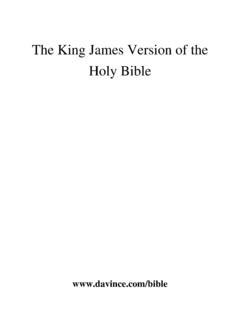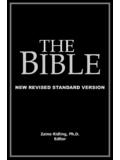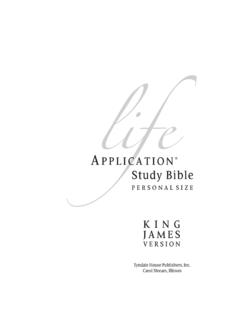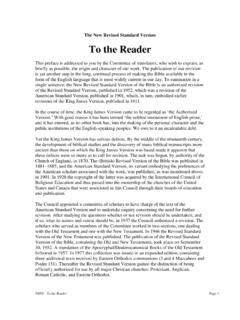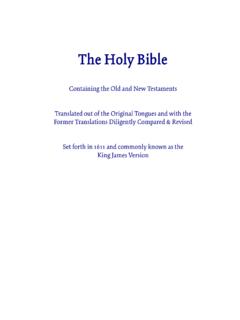Transcription of The New King James Version: In the Great Tradition
1 The New king James version : In the Great Traditionby Arthur Farstad(Nashville, TN: Thomas Nelson, 1989), 171pp., author initially served as the New Testament Editor and later, as Executive Editor forthe New king James translation project. Thus, he is intimately familiar with thisparticular modern translation and the principles behind its development. It also makes histreatment of the subject somewhat less objective at book is intended to address questions on a popular, rather than technical level. In hisforward, R. K. Harrison identifies some of the popular questions:What changes were made and why?
2 Who was involved with the project? Didthey believe in the inspiration, inerrancy, and infallibility of the Scriptures?Were the original languages considered? How long did it take to do all this?Who paid for it? Why a New king James ? Why not a completely newtranslation?The style of the book makes it both easy to read and interesting. Those looking fortechnical detail concerning translation theory or the treatment of problem passages by theNKJV translators will not find such issues dealt with here. The author evaluates the NKJV translation according to three primary criteria: accuracy(chapters 1 through 4), beauty (chapters 5 through 8); and completeness (chapters 9through 12).
3 Concerning accuracy, the author surveys the various English translations leading up tothe venerable king James version and explains their contribution to the traditional textwhich also underwrites the New king James version . Having explained the desire of theNKJV translation committee to update the excellent KJV translation, Farstad lists thevarious guidelines which were established by the translators to guide their work ofupdating the KJV text while preserving much of its heritage. Numerous examples aregiven of passages where KJV terminology was rendered differently by the NKJV andexplaining the reasons why usually due to changes in language with time or a bettergrasp of the underlying Hebrew or Greek terms since the time of the KJV beauty, the author explains the desire of the NKJV translators to preserve themajesty and literary qualities for which the KJV is rightfully known.
4 Presentationimprovements in the area of phrasing (poetry) and fulfillment (quotation of the OT in theNT) are explained. The final chapter in this section is perhaps the weakest describingthe desire of the NKJV translation to render Hebrew idioms in a manner more acceptableto polite company:The contemporary mass media often revel in vulgar language. But is it rightfor Christian children to find in their Bibles what they are taught are no-no words elsewhere? We think New king James version : In the Great Tradition1 But is this the correct question to be asking?
5 The question should not be can childrenread the Bible without encountering harsh realities including language that may seemvulgar in places, but what is the most accurate rendering of the underlying Hebrew orGreek text, period. The unfortunate result of the tendency of the translators to applyperfume to some of the more vivid word-pictures, especially in the OT, is that theintended punch of what God had specifically intended to describe can be watered downand lose its original impact on the modern reader. After (rightly) arguing for the primacyof verbal inspiration, it is disappointing to see how casually words in the original text arelaundered for a polite Bible-reading audience.
6 We would prefer to do away with suchlaundering and allow readers to be shocked by the rawness of God's communication inthose completeness, the author discusses the various text behind both the OldTestament and New Testament. The treatment concerning the New Testament text is ofmore interest since this is where the NKJV translators chose to part ways from themajority of modern English translations which have favored the critical, rather thantraditional , the NKJV textual policy in the New Testament is more objectivethan that in any modern version of which we are aware.
7 Translators of mostcontemporary versions assume that the currently popular view is correct andthey often label those readings supporting their theory as the bestmanuscripts. Also, manuscripts supporting the KJV-type reading are largelyignored. Since these latter readings almost always reflect the readings ofeighty percent of the extant manuscripts, and very frequently close to ninety-five percent of the manuscripts, this labeling policy seems a bit approach taken by the NKJV translation results in what to this reviewer is one of itsgreatest strengths a text which favors the Byzantine textual family, but which carefullyfootnotes variations between three main textual streams.
8 The critical text (designated as NU for Nestle-Aland/United Bible Societies text), the majority text (designated MT)and the received text (or textus receptus, TR). The NKJV committee reasoned that thelarger number of manuscripts containing traditional renderings might well indicate asuperior textual line with wider circulation. Hence, the NKJV differs from most mostmodern translations in denying priority to the relatively few (and fragmentary)Alexandrian texts and favoring the received or majority book closes with a brief treatment of three translation methods: (1) literal translation;(2) dynamic equivalence translation; and (3) complete equivalence translation, which isdefined as basically the literal method updated to include scientific insights fromlinguistic analysis.
9 Here, the author argues that the NASB translation is perhaps overlyliteral in its rendering of connectives, but recognizes that the NKJV and NASB stand inthe same camp (essentially literal) when compared to many other popular translationswhich favor dynamic equivalence translation (extreme forms of which are paraphrases).The book includes several appendices listing the translation, editorial, and reviewcommittee members who contributed to the NKJV New king James version : In the Great Tradition2 This book is recommended as an introductory popular-level treatment of the NKJV translation which includes a brief treatment of some of the issues which any translationmust deal with in rendering the Word of God in by Tony Garland of New king James version : In the Great Tradition3


